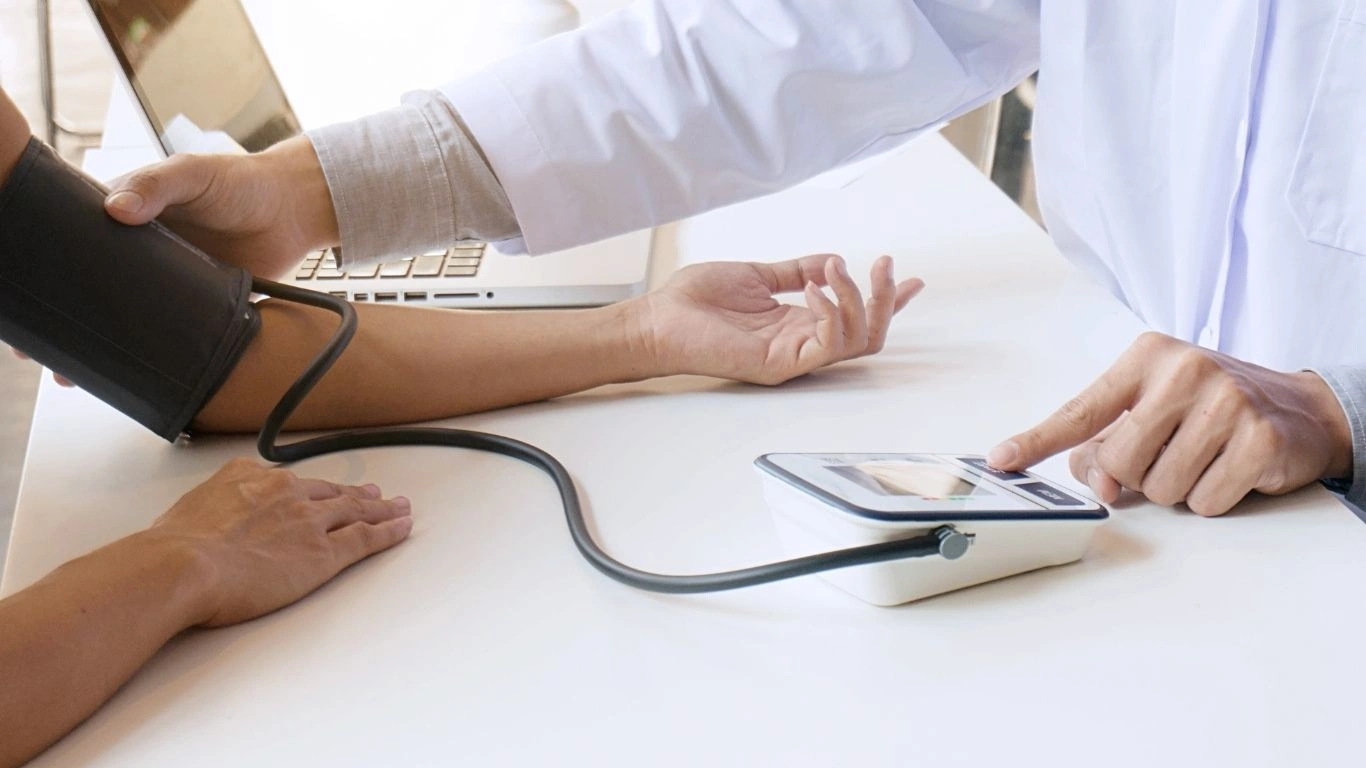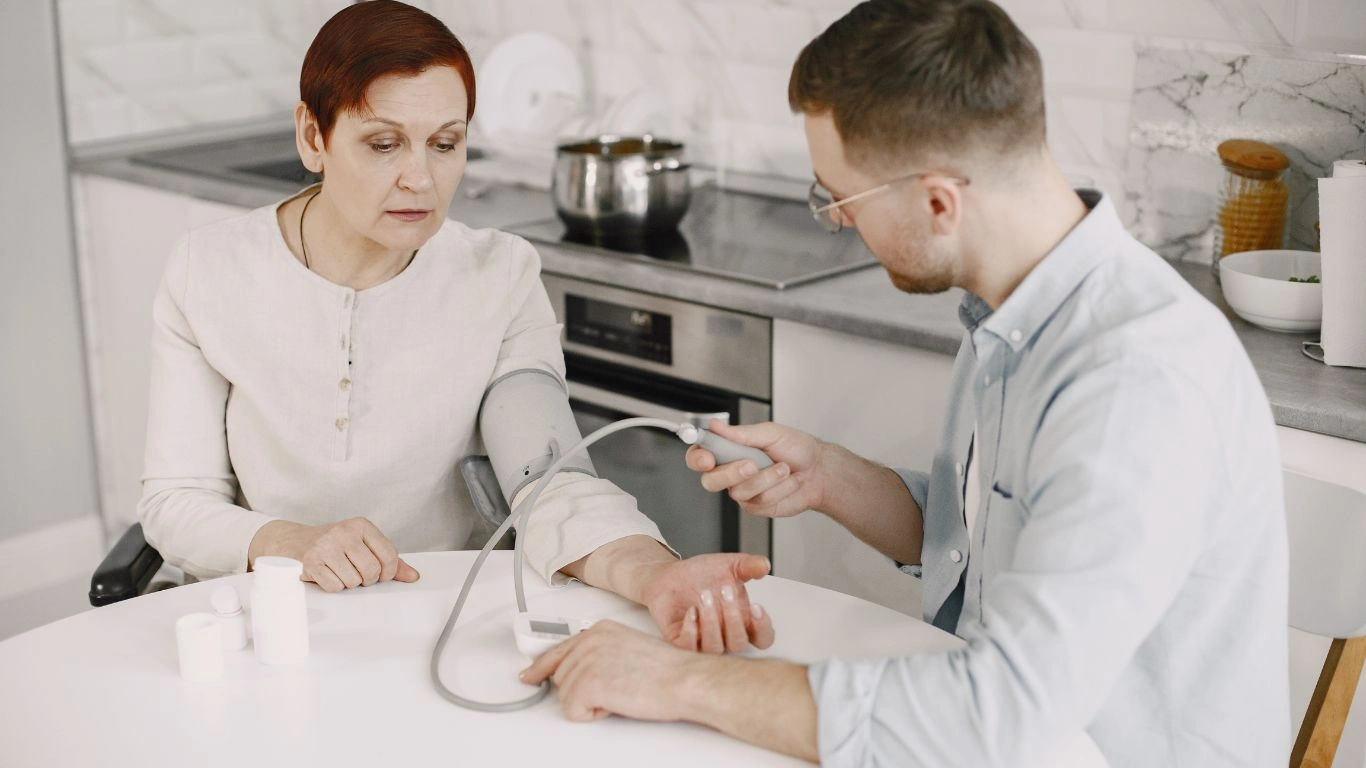How to Support Healthy Blood Pressure During Menopause Naturally
As an internal medicine physician specializing in hypertension management, I’ve seen firsthand how challenging it can be to maintain healthy blood pressure during menopause. Many of my patients come to me concerned about sudden spikes in blood pressure, mood swings, and even weight gain. Menopause is a natural phase of life, but it brings with it a variety of changes in the body, including fluctuations in hormones that can affect cardiovascular health. That’s why understanding how to support healthy blood pressure during menopause is crucial for maintaining your overall well-being. It’s not just about avoiding high blood pressure – it’s about managing it in a way that keeps you feeling good, physically and emotionally.
Understanding Menopause and Blood Pressure Changes

Menopause typically begins around age 50, though it can start earlier or later for some women. During this time, the ovaries gradually produce less estrogen and progesterone, two hormones that play a key role in regulating various body functions, including your cardiovascular system. As estrogen levels decline, blood vessels may lose some of their elasticity, which can lead to higher blood pressure. This, coupled with the natural aging process, puts women at greater risk for hypertension as they enter menopause.
The relationship between menopause and hypertension is complex, and it can vary from woman to woman. Some might experience only mild changes in blood pressure, while others may notice more significant increases. If you already have a family history of hypertension, diabetes, or cardiovascular disease, these factors can further raise your risk. And let’s not forget about the stress that often accompanies this life stage—whether it’s due to hormonal changes, lifestyle factors, or even personal circumstances, stress can be a major contributor to elevated blood pressure.
Hormonal Fluctuations: A Major Culprit
To understand the impact of menopause on blood pressure, it’s essential to recognize how hormones play a role. Estrogen is known to help keep blood vessels dilated and relaxed, which contributes to lower blood pressure. As estrogen levels dip during menopause, blood vessels may become more constricted, resulting in higher pressure. This is why so many women notice an increase in blood pressure around the time of menopause.
Additionally, the decrease in progesterone can also play a part. Progesterone helps maintain the balance of sodium and water in the body. Without enough of it, the body may retain more fluid, which can increase blood pressure. The combined effect of fluctuating estrogen and progesterone levels can make it difficult to maintain healthy blood pressure during this phase of life.
How Lifestyle Choices Impact Blood Pressure During Menopause

It’s not all about hormones, though. Lifestyle choices have a significant impact on your blood pressure during menopause. A healthy lifestyle can make a world of difference in how your body responds to the changes you’re going through. Let’s take a closer look at the key lifestyle factors that play a role.
Physical Activity: Your Secret Weapon
If there’s one thing I always emphasize to my patients, it’s the importance of regular physical activity. Exercise is one of the most effective ways to keep your blood pressure in check during menopause. Studies have shown that moderate-intensity exercise, such as brisk walking, swimming, or cycling, can help lower blood pressure, reduce stress, and improve cardiovascular health. And the best part? It’s not just about weight loss (although that’s a bonus); it’s about improving your heart’s efficiency and helping your blood vessels stay flexible and healthy.
But let’s be honest—sometimes it can feel overwhelming to commit to a regular workout routine, especially when you’re dealing with the other symptoms of menopause like fatigue or sleep disturbances. Start small and find an activity you enjoy. You don’t need to be a marathon runner to benefit from exercise. Even daily 20-minute walks can have a positive impact on your health.
Diet: Eating for Healthy Blood Pressure
Another powerful tool for managing blood pressure is nutrition. What you eat can either support or hinder your efforts to keep your blood pressure under control. A balanced, heart-healthy diet is key during menopause, and there are several foods that can help support healthy blood pressure.
One of the most important dietary changes to consider is reducing your sodium intake. High sodium consumption is a major contributor to elevated blood pressure. Menopause can make your body more sensitive to salt, so it’s a good idea to be mindful of how much sodium you’re consuming. Aim to limit processed and packaged foods, which tend to be high in sodium, and focus on whole foods like fresh fruits, vegetables, lean proteins, and whole grains.
- Leafy greens, such as spinach and kale, are rich in potassium, which can help balance sodium levels in your body.
- Fatty fish, like salmon and mackerel, are excellent sources of omega-3 fatty acids, which have been shown to help lower blood pressure.
- Beets are rich in nitrates, which can help relax blood vessels and improve blood flow.
Don’t forget about hydration! Drinking plenty of water throughout the day helps maintain fluid balance and supports your overall cardiovascular health. I always recommend my patients aim for at least eight 8-ounce glasses of water a day, but individual needs may vary based on activity levels and climate.
Mindful Stress Management
Stress management is another essential component in maintaining healthy blood pressure during menopause. As I mentioned earlier, menopause can bring about emotional and psychological changes, such as mood swings and anxiety, which can contribute to stress. Chronic stress activates the body’s fight-or-flight response, leading to an increase in heart rate and blood pressure.
Taking time to relax and de-stress is just as important as eating well and exercising. Practices like deep breathing, meditation, yoga, and even hobbies that bring you joy can help reduce the negative effects of stress. Mindfulness and relaxation techniques have been shown to lower blood pressure, improve mental well-being, and help you better cope with the challenges of menopause.
Incorporating stress-reducing activities into your daily routine, even if it’s just for 10 minutes, can have a profound effect on how you feel both mentally and physically. It’s all about finding balance during this transformative phase of life.
Medical Options for Supporting Healthy Blood Pressure During Menopause

While lifestyle changes like exercise and diet are incredibly powerful tools, sometimes they aren’t enough on their own, especially if your blood pressure has already reached concerning levels. That’s where medical options come in. As a physician, I often work with my patients to explore both non-pharmacological and pharmacological treatments for managing blood pressure during menopause. The goal is to tailor a plan that fits your specific health needs, lifestyle, and any underlying conditions you may have.
Non-Pharmacological Approaches
Before jumping to medications, I always suggest trying to manage blood pressure with lifestyle changes first, when possible. But there are some non-drug interventions that can really help in conjunction with the lifestyle changes I’ve mentioned earlier. For example, one area we focus on is regular monitoring of blood pressure. Getting familiar with your own numbers gives you and your doctor a better picture of what’s going on in your body, and it allows us to spot any worrying trends early.
Another non-medication approach is cognitive behavioral therapy (CBT) for stress management. It’s been shown that chronic stress can elevate blood pressure over time, and menopause can bring a lot of stress – physical, emotional, and even lifestyle-related. CBT helps women reframe their thoughts, reduce anxiety, and manage stress better, which directly benefits heart health.
Pharmacological Treatment Options
Sometimes, lifestyle changes alone may not be enough to control blood pressure, especially if you’re dealing with other risk factors like obesity, high cholesterol, or diabetes. In these cases, your doctor may recommend medications. The goal is to find a treatment that works for you while minimizing side effects. Let’s talk about some of the common classes of medications used to manage blood pressure in women going through menopause.
- ACE Inhibitors (Angiotensin-Converting Enzyme Inhibitors): These medications relax blood vessels and help lower blood pressure. They can be particularly beneficial for women who have kidney issues, as they also protect the kidneys from damage.
- Beta-Blockers: These are often prescribed to lower blood pressure and heart rate. They are particularly helpful for people who experience heart palpitations or anxiety as part of their hypertension.
- Diuretics: Known as “water pills,” diuretics help the body get rid of excess salt and water, which can relieve pressure on the blood vessels.
- Calcium Channel Blockers: These medications help relax and widen blood vessels, which reduces the amount of work the heart has to do, leading to lower blood pressure.
Of course, every medication comes with potential side effects, so it’s important to have a thorough conversation with your healthcare provider about your options. Sometimes, it’s a process of trial and error to find the best medication or combination that works for you.
The Role of Hormone Replacement Therapy (HRT) in Blood Pressure Management

Now, I know that hormone replacement therapy (HRT) can be a controversial topic, but it’s one worth discussing, especially when it comes to managing menopause symptoms and blood pressure. HRT can be helpful for some women, as it replaces the hormones that decline during menopause, such as estrogen and progesterone. For many, this can ease symptoms like hot flashes, night sweats, and mood swings, and it might even have a positive impact on blood pressure.
Some studies suggest that HRT may actually help lower blood pressure in certain women by restoring estrogen levels, which, as I mentioned earlier, play a role in keeping blood vessels healthy. Estrogen helps the blood vessels remain flexible, so when estrogen is replaced, it can improve blood flow and reduce the risk of hypertension. However, it’s essential to note that HRT isn’t for everyone, and it can come with risks, such as an increased risk of blood clots, stroke, and breast cancer. The decision to start HRT should always be made in collaboration with your healthcare provider, who will help weigh the potential benefits and risks based on your personal medical history.
Alternatives to Traditional Hormone Replacement Therapy
If HRT isn’t an option or if you prefer not to take hormones, there are alternative treatments available. Some women find relief from menopause symptoms and blood pressure control through plant-based estrogens, such as phytoestrogens. These are plant-derived compounds found in foods like soy, flaxseeds, and certain legumes, which mimic estrogen in the body but have weaker effects.
Another alternative treatment gaining popularity is black cohosh, a herb commonly used to manage hot flashes and other menopausal symptoms. There’s some evidence to suggest that it might have a positive effect on cardiovascular health, although more research is needed. As with any supplement, it’s important to talk to your doctor before trying new alternatives to ensure they won’t interfere with any medications you’re currently taking.
Importance of Regular Monitoring and Checkups

One of the most important steps in managing blood pressure during menopause (and life in general) is regular monitoring. Many women go through menopause without realizing that their blood pressure is creeping up until it’s too late. In my practice, I encourage patients to keep track of their blood pressure at home, especially if they’re at higher risk for hypertension or have already been diagnosed with high blood pressure. Home blood pressure monitors are easy to use and can provide valuable information that helps guide treatment decisions.
In addition to home monitoring, regular checkups with your doctor are essential. At these visits, we can check your blood pressure, review your current treatment plan, and make any necessary adjustments. This is also a great time to discuss any new symptoms you may be experiencing, ask questions, and get advice on how to continue managing your health. Early detection is key, and being proactive about your health now can prevent more serious complications down the road.
Don’t be afraid to speak up during your appointments—ask questions, share your concerns, and make sure you understand your treatment options. Blood pressure management during menopause is a journey, and having a collaborative relationship with your doctor can help ensure the best possible outcomes.
Long-Term Strategies for Maintaining Healthy Blood Pressure Post-Menopause

As you continue through menopause and beyond, maintaining healthy blood pressure becomes a long-term commitment. It’s not just about managing symptoms for a few months – it’s about building a sustainable lifestyle that supports heart health for the years to come. From my experience, women often feel overwhelmed by the many changes menopause brings, but the good news is that with the right strategies, managing blood pressure doesn’t have to be a constant battle. It’s all about adopting habits that you can keep up for the long haul.
Building a Sustainable Routine
One of the biggest hurdles in managing blood pressure during menopause is consistency. It’s easy to get excited about new habits like exercising more or eating better, but it’s important to make these changes stick. This is where establishing a routine comes into play. Whether it’s starting your day with a 10-minute stretch, eating a heart-healthy breakfast, or taking a 30-minute walk in the evening, routines help ensure that these practices become part of your daily life.
Creating a balanced daily schedule that includes physical activity, time for relaxation, and healthy meals can go a long way toward helping you stay on track. Remember, it’s not about perfection. Life happens, and there will be days when you don’t quite hit your targets. The key is to pick yourself back up and keep going. I tell my patients to treat their health like a long-term investment. It’s not about making drastic changes overnight – it’s about making small, sustainable changes that add up over time.
The Importance of Sleep for Blood Pressure Management

We often overlook the role that sleep plays in managing blood pressure, but let me tell you – it’s huge. When I talk to patients about blood pressure, I always stress the importance of getting enough sleep. Quality sleep is essential for overall cardiovascular health, and menopause can disrupt sleep patterns due to hot flashes, night sweats, and changes in hormone levels. The resulting sleep deprivation can lead to increased stress and higher blood pressure.
Getting a solid 7-9 hours of sleep each night is one of the best ways to support your heart health. If you’re struggling with sleep issues during menopause, try to develop a calming bedtime routine. This could include practices like reading a book, doing gentle stretches, or practicing deep breathing. You can also experiment with cooling devices, like a fan or cooling pillow, to help reduce the effects of hot flashes during the night.
In some cases, if sleep disruptions are severe, talking to your healthcare provider about treatment options is a good idea. This could include short-term use of sleep aids or even therapies like cognitive behavioral therapy for insomnia (CBT-I), which has been shown to help people improve their sleep without relying on medications.
Mindset and Mental Health
Another critical element in maintaining healthy blood pressure during menopause is your mindset. Menopause can bring about emotional changes, and feeling overwhelmed or anxious can directly impact your heart health. From my practice, I’ve seen how vital it is for women to focus on their mental health during this time.
It’s easy to get bogged down by the challenges of menopause, but adopting a positive, proactive mindset can make a significant difference. I encourage my patients to think of menopause not just as a physical transition but as an opportunity to take charge of their health and well-being. Instead of focusing on the negatives, try to focus on the positives – this could be the chance to explore new hobbies, improve your fitness, or prioritize self-care. Remember, a positive mindset can help lower stress levels and support heart health over the long term.
References and Further Reading
If you’re looking to dive deeper into the topic of menopause and blood pressure, there are a number of trusted resources that can provide further insights:
Disclaimer
While I’ve shared the advice and insights based on my experience as a physician specializing in hypertension management, please remember that each individual’s health situation is unique. The information provided here is intended for general informational purposes and should not be used as a substitute for professional medical advice, diagnosis, or treatment. Always consult your healthcare provider before making any changes to your lifestyle, medications, or treatment plans, especially during menopause, as it is a complex and individualized process.

Dr. Gwenna Aazee is a board-certified Internal Medicine Physician with a special focus on hypertension management, chronic disease prevention, and patient education. With years of experience in both clinical practice and medical writing, she’s passionate about turning evidence-based medicine into accessible, actionable advice. Through her work at Healthusias.com, Dr. Aazee empowers readers to take charge of their health with confidence and clarity. Off the clock, she enjoys deep dives into nutrition research, long walks with her rescue pup, and simplifying medical jargon one article at a time.





